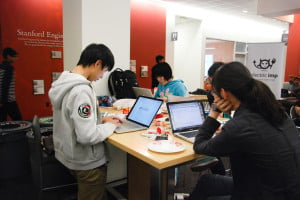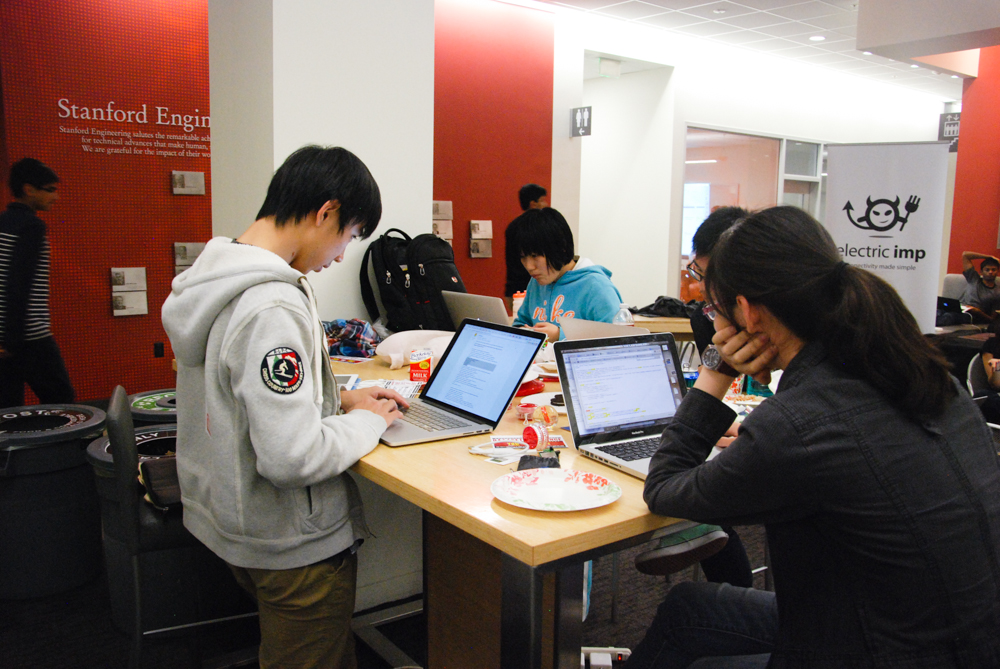
Three hundred students gathered in the basement of Stanford’s Jen-Hsun Huang Engineering Center on Saturday for the Big Hack, the annual hackathon that pits Stanford against UC-Berkeley.
The Big Hack was organized by three Stanford groups – BASES’s Hackspace, the Stanford Association for Computer Machinery (ACM) and Hack Stanford – in addition to Berkeley’s hacking club. This was the event’s third year, and, according to ACM president Karthik Viswanathan ’15, the number of participants has increased by about 100 students each year.
Last year, Stanford students made up 15 percent of the approximately 200 participants. Although only 80 of the hackers this year were Stanford students, both organizers and participants framed the relative gain as reflective of an ascendant hacking culture at the University.
Although Berkeley’s significantly larger population partly accounts for the difference in registration between the two schools, Viswanathan also spoke about a difference in culture.
“I think Berkeley has a bigger hacking culture than Stanford does,” Viswanathan said. “There’s a strong entrepreneurial culture here, but that’s different from hacking.”
Viswanathan explained that entrepreneurship often focuses on the profits a product will make, while hacking is building a product or application for the sake of enjoyment. ACM aims to promote a greater hacking culture on campus through events like the Big Hack.
As both an organizer and participant in the Big Hack, Jason Teplitz ’17 admitted that he was surprised by the lack of hackers at Stanford but said that he expects to see the culture grow in the near future.
“[Stanford’s hacking] is up and coming,” Teplitz said. “It was shocking to not see a big culture here, but I would be surprised if that doesn’t change.”
Teplitz explained that a hackathon can act as a good launch point for a project but that many people are intimidated by the idea of starting from scratch.
“If you force yourself to sit down and do something, you learn so much about the process, but I think that process scares people,” Teplitz said. “There are so many people that are good at CS, but when they don’t have an assignment and they can do whatever they want, they don’t know where to start.”
As a regular participant in hackathons, Teplitz still finds new ways to experiment at each event.
“You just brainstorm anything you think would be awesome,” Teplitz said. “[It] doesn’t have to be some crazy hardware – could be a simple web app. It’s just a way to learn something new.”
Participant and ACM officer Sydney Li ’17 noted that the Big Hack was only her second hackathon. She used the 24-hour period to create a Facebook application that graphs a user’s mood based on his or her past statuses.
“You’ll never be able to implement what you learn in class aside from things in assignments,” Li said. “Most things in the industry [you learn] by working for them or by experimenting on your own.”
Kevin Hsu ’15, a Hack Space officer who helped organize the event, also emphasized the importance of hackathons in helping coders experience the real applications of programming.
“It’s always exciting to see what people make,” Hsu said. “A lot of people come to college wanting to make something…but they don’t have time to pursue their own personal projects. During the hackathon, students can do what they want to do.”
At the end of the allotted time, 37 Berkeley teams and 11 Stanford teams presented their projects to a panel of judges. Teams were evaluated based on their products’ user interface, functionality and usefulness. Prizes included Pebble watches, Oculus Rifts and MacBook Airs. Although Berkeley teams took first and third, a Stanford team called Venture won second.
Venture, created by Amy Bearman ’16, Alanna Tempest ’16, Keenon Werling ’16 and Jan Dlabal ’16, is an app that generates different types of nearby activities based on a user’s preferences. The team attributed much of their success to brainstorming the project in advance of the hackathon.
“A good idea is something that you would actually want to use,” Bearman said. “Having built Venture, we’ve actually used it to figure out restaurants that we would want to go to. It’s something that we felt that we had a need for so we were motivated to create it.”
For Bearman and Tempest, the Big Hack was their second hackathon while Werling and Dlabal had participated in past competitions as well. Werling said that in the future, they hope to create a Stanford hacking club to bring together hackers on campus.
“It would be nice to have a hackathon club where what we do is say we’re treating this like a sports team,” Werling said. “There will be tryouts – if you are good, you’re in. If you’re not, you’re on junior varsity.”
They also noted that the club would compile resources that programmers could use in order to reduce the amount of time wasted on setup at hackathons.
“You need to do other projects in order to get a sense of what you enjoy and what you’re good at if you really practice for hackathons,” Tempest said. “[It] would be fun to set up a software stack for hackathons – easy tools that everyone knows how to use.”
Teplitz, Li and the four members of Venture are among the 180 Stanford students who will attend the LA Hacks hackathon this weekend. According to organizer Shrav Mehta, the event will host a total of around 1500 participants from several different colleges.
Contact Kylie Jue at kyliej ‘at’ stanford ‘dot’ edu.
